2025年安徽中考英语 第二部分 第六节 形容词和副词
文档属性
| 名称 | 2025年安徽中考英语 第二部分 第六节 形容词和副词 | 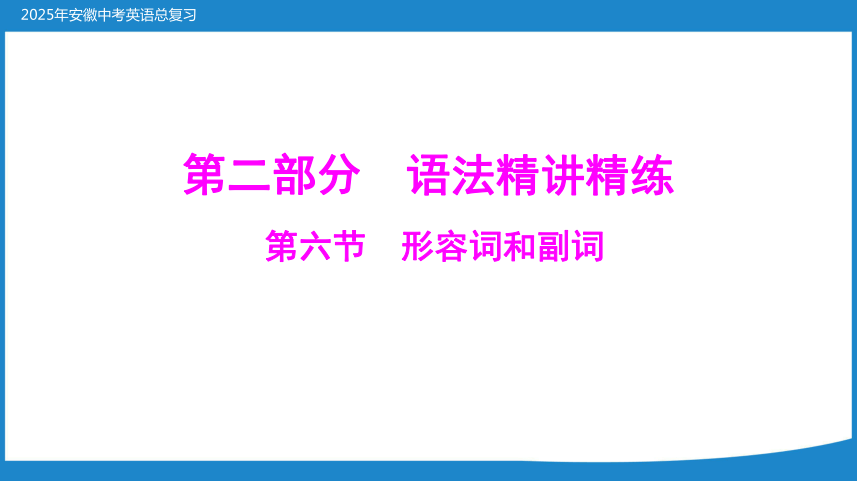 | |
| 格式 | ppt | ||
| 文件大小 | 834.5KB | ||
| 资源类型 | 试卷 | ||
| 版本资源 | 通用版 | ||
| 科目 | 英语 | ||
| 更新时间 | 2025-02-27 17:15:29 | ||
图片预览


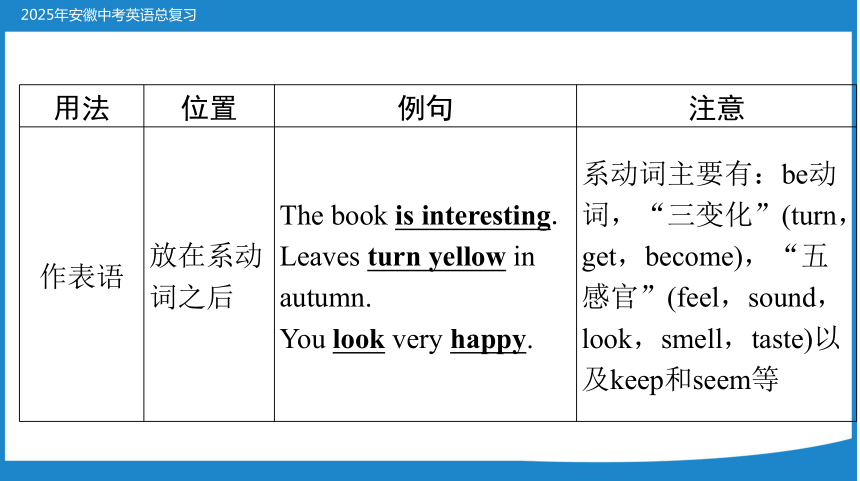
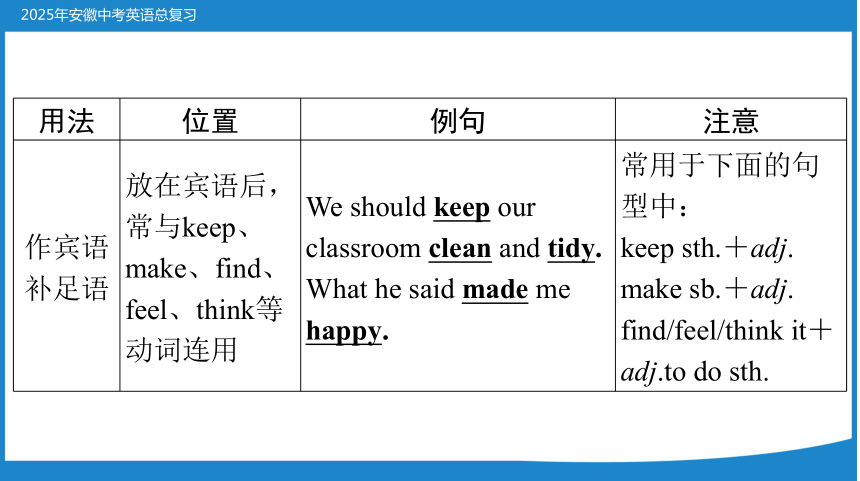
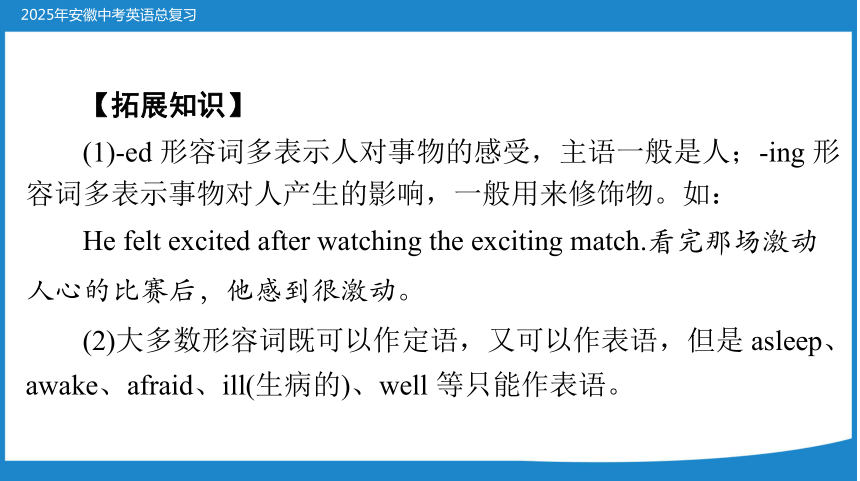
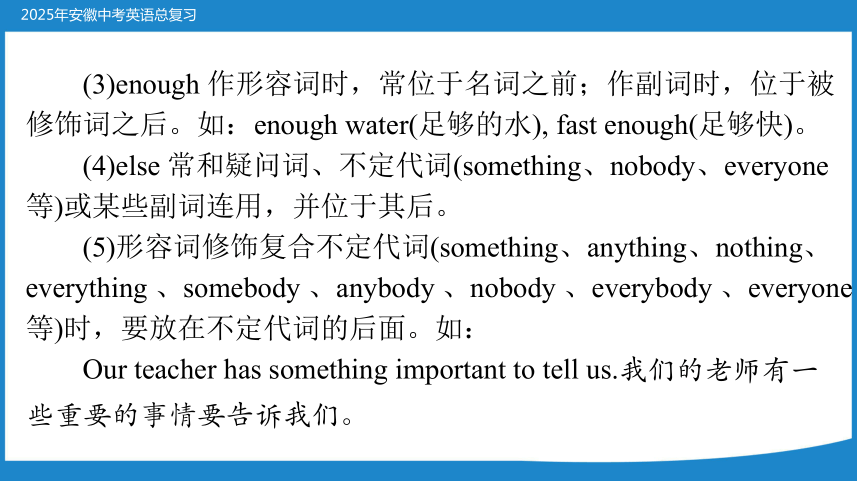
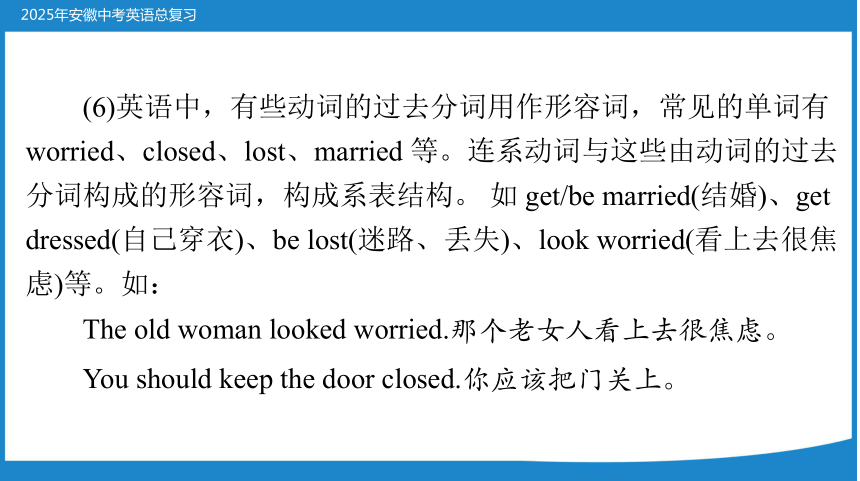
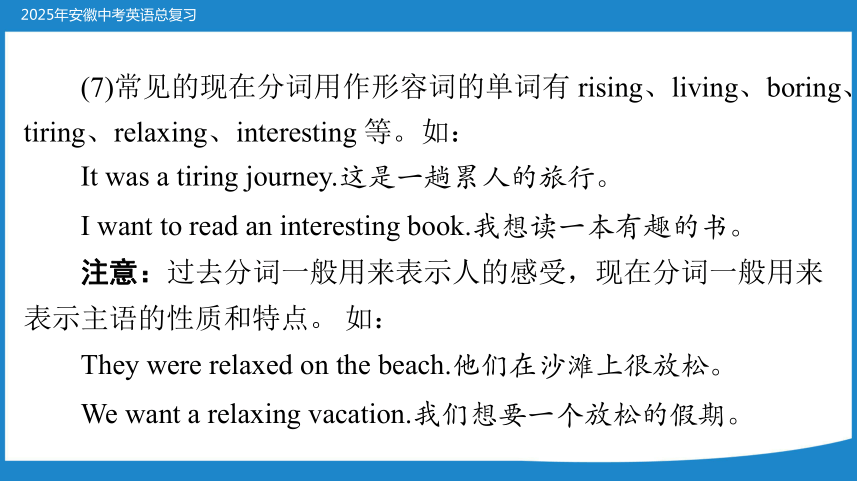
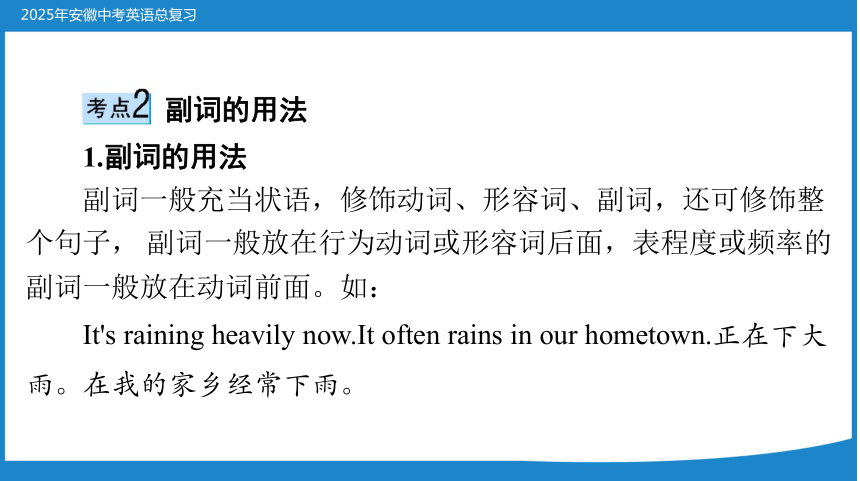
文档简介
(共22张PPT)
第六节
形容词和副词
第二部分
语法精讲精练
用法 位置 例句 注意
作定语 放在名词前 This is an interesting book. \
形容词的用法
形容词是用来说明人或事物特征、性质或状态的词。考纲中
要求掌握的用法如下:
用法 位置 例句 注意
作表语 放在系动词之后 The book is interesting.
Leaves turn yellow in autumn.
You look very happy. 系动词主要有:be动词,“三变化”(turn,get,become),“五感官”(feel,sound,look,smell,taste)以及keep和seem等
用法 位置 例句 注意
作宾语
补足语 放在宾语后,常与keep、make、find、feel、think等动词连用 We should keep our classroom clean and tidy.
What he said made me happy. 常用于下面的句型中:
keep sth.+adj.
make sb.+adj.
find/feel/think it+adj.to do sth.
【拓展知识】
(1)-ed 形容词多表示人对事物的感受,主语一般是人;-ing 形
容词多表示事物对人产生的影响,一般用来修饰物。如:
He felt excited after watching the exciting match.看完那场激动
人心的比赛后,他感到很激动。
(2)大多数形容词既可以作定语,又可以作表语,但是 asleep、
awake、afraid、ill(生病的)、well 等只能作表语。
(3)enough 作形容词时,常位于名词之前;作副词时,位于被
修饰词之后。如:enough water(足够的水), fast enough(足够快)。
(4)else 常和疑问词、不定代词(something、nobody、everyone
等)或某些副词连用,并位于其后。
(5)形容词修饰复合不定代词(something、anything、nothing、
everything 、somebody 、anybody 、nobody 、everybody 、everyone
等)时,要放在不定代词的后面。如:
Our teacher has something important to tell us.我们的老师有一
些重要的事情要告诉我们。
(6)英语中,有些动词的过去分词用作形容词,常见的单词有
worried、closed、lost、married 等。连系动词与这些由动词的过去
分词构成的形容词,构成系表结构。 如 get/be married(结婚)、get
dressed(自己穿衣)、be lost(迷路、丢失)、look worried(看上去很焦
虑)等。如:
The old woman looked worried.那个老女人看上去很焦虑。
You should keep the door closed.你应该把门关上。
(7)常见的现在分词用作形容词的单词有 rising、living、boring、
tiring、relaxing、interesting 等。如:
It was a tiring journey.这是一趟累人的旅行。
I want to read an interesting book.我想读一本有趣的书。
注意:过去分词一般用来表示人的感受,现在分词一般用来
表示主语的性质和特点。 如:
They were relaxed on the beach.他们在沙滩上很放松。
We want a relaxing vacation.我们想要一个放松的假期。
副词的用法
1.副词的用法
副词一般充当状语,修饰动词、形容词、副词,还可修饰整
个句子, 副词一般放在行为动词或形容词后面,表程度或频率的
副词一般放在动词前面。如:
It's raining heavily now.It often rains in our hometown.正在下大
雨。在我的家乡经常下雨。
2.副词的分类
(1)时间副词:ago、before、already、now、just、soon、then、
yet、always、usually、often、sometimes、never、ever 等。
(2)地点副词:here、there、in、out、back、home 等。
(3)程度副词:very、much、only、quite、too、so、nearly、
enough、 hard、still 等。
(4)疑问副词:when、where、how、why 等。
(5)方式副词:quickly、slowly、carefully、loudly、strongly、
badly、happily 等。
3.形容词变成副词的规律
(1) 直 接 加 ly 构 成 , 如 : quick→quickly, careful→carefully,
sudden→suddenly
(2)以辅音字母加 le 结尾的词,去 e 加 y,如:terrible→terribly
(3) 以 辅 音 字 母 加 y 结 尾 的 词 , 改 y 为 i , 再 加 ly , 如 :
heavy→heavily
(4)其他变化,如:true→truly, full→fully
(5)形容词与副词同形,如:fast, early, hard, high, straight
(6)daily、lovely、friendly、lonely、ugly、likely 等是形容词,
不是副词。
形容词和副词的比较等级
1.形容词、副词比较级和最高级的构成
(1)单音节和少数双音节形容词比较级和最高级的构成规律。
①一般单词都是在词尾加 er 、est 构成。如 great(greater ,
greatest)、hard(harder,hardest)、cheap(cheaper,cheapest)等。
②如果单词以字母 e 结尾(e 不发音) ,直接加上 r 、st 。如
wide(wider,widest)、large(larger,largest)等。
③以重读闭音节结尾的单音节词,需双写词尾的辅音字母,
再加 er、est。如 hot(hotter,hottest)、big(bigger,biggest)等。这个
变化规则与现在分词、过去式和过去分词的拼写规则一样。
④以辅音字母+y 结尾的双音节形容词要变 y 为 i,再加 er、
est。如 early(earlier,earliest)、happy(happier,happiest)等。
⑤少数以 er 结尾的双音节形容词,其比较级和最高级也是加
er、est。如:clever(cleverer,cleverest)等。
(2)多音节形容词比较级、最高级的构成规律。
多音节形容词一般要在形容词前加 more 或 most 构成比较级、
最高级形式。如:more interesting(更有趣的)、the most dangerous(最
危险的)等。
(3)形容词、副词的比较级和最高级的不规则变化。
常见的形容词、副词的比较级和最高级的不规则变化有 good、
well、bad、ill、many、little、few、far、old 这几个单词。归纳如
下:
原级 比较级 最高级
good(好的), well(健康的;好) better best
bad(坏的),ill(有病的) worse worst
many,much(多的) more most
little,few(小的,少的) less,fewer least,fewest
far(远的) farther/further farthest/furthest
old(年岁大的) older/elder oldest/eldest
2.形容词、副词原级的用法
(1)“A+谓语动词+as+原级+as+B”表示 A、B 两者程度
相同。如:
Jim is running as fast as Bruce.They are neck and neck.吉姆和布
鲁斯跑得一样快。他们旗鼓相当。
(2)“A+谓语动词的否定式+as/so+原级+as+B”表示“A
不如 B……”。如:
Luckily,the weather is not so(as) bad as yesterday.幸好天气没
有昨天那样糟。
3.形容词、副词比较级的用法
比较级表示两者之间的比较,常用的有如下的结构:
(1)“A + 谓 语 动 词 + 比 较 级 + than + B” 表 示 “A 比
B……”。如:
He runs much faster than Tom.他比汤姆要跑得快得多。
在比较级前用 much、even、still 等词修饰,表示加强语气。
如:
He did his homework much more carefully than her.他做作业要
比她仔细得多。
(2)“A+谓语动词+比较级+than+any other+单数名词(+
介词短语)”,或者“A+谓语动词+比较级+than+the other+名
词复数(+介词短语)”表示“A 比任何人或物都……”,有“A 是
最……”的意思。如:
Mike is taller than any other student in our class.=Mike is taller
than the other students in our class.迈克是我们班最高的学生。
(3)“A+谓语动词+the+比较级+of the two+…”表示“两
者中较……的”。如:
He is the more careful of the two engineers.他是两名工程师中
较细心的一个。
(4) “比较级+and+比较级”表示“越来越……”。如:
Winter is coming and the days are getting colder and colder.冬天
要到了,天变得越来越冷了。
(5)“the+比较级,the+比较级”表示“越……就越……”。
如:
The harder you work,the better grades you will get.你学习越努
力,成绩就越好。
(6)“A +谓语动词+less +原级+than +B”表示“A 不如
B……”。如:
I think pop music is less beautiful than classic music.我认为流行
音乐没有古典音乐那么好听。
【拓展知识】
比较级前面一般没有定冠词 the,但遇到以下句型时要用 the:
He is the heavier of the two boys.他是两个男孩子中更重的那
个。
Lily is the cleverer of the twins. 莉莉是双胞胎中更聪明的那
个。
4.形容词、副词最高级的用法
最高级用于三者或三者以上的比较,表示在某一范围内或某
类人物中“最……”,常用的有如下的结构:
(1)“主语+谓语动词+the+最高级+( 单数名词)+in/of 短
语”表示“……是……中最……的”。如:
Who is the strongest of the four boys 谁是那四个男孩中最强
壮的?
注意:表示最高级必须有一定的范围。
(2)“主语+谓语动词+one of the+最高级+复数名词+in/of
短语”表示“……是最……之一”。如:
She is one of the most beautiful girls in the school.她是学校里最
漂亮的女孩之一。
(3)“特殊疑问词+谓语动词+the+最高级+A,B,or C?”
用于三者或三者以上的比较。 如:
Which is the heaviest, an elephant, a horse or a cow?大象、马、
牛之中哪个最重?
第六节
形容词和副词
第二部分
语法精讲精练
用法 位置 例句 注意
作定语 放在名词前 This is an interesting book. \
形容词的用法
形容词是用来说明人或事物特征、性质或状态的词。考纲中
要求掌握的用法如下:
用法 位置 例句 注意
作表语 放在系动词之后 The book is interesting.
Leaves turn yellow in autumn.
You look very happy. 系动词主要有:be动词,“三变化”(turn,get,become),“五感官”(feel,sound,look,smell,taste)以及keep和seem等
用法 位置 例句 注意
作宾语
补足语 放在宾语后,常与keep、make、find、feel、think等动词连用 We should keep our classroom clean and tidy.
What he said made me happy. 常用于下面的句型中:
keep sth.+adj.
make sb.+adj.
find/feel/think it+adj.to do sth.
【拓展知识】
(1)-ed 形容词多表示人对事物的感受,主语一般是人;-ing 形
容词多表示事物对人产生的影响,一般用来修饰物。如:
He felt excited after watching the exciting match.看完那场激动
人心的比赛后,他感到很激动。
(2)大多数形容词既可以作定语,又可以作表语,但是 asleep、
awake、afraid、ill(生病的)、well 等只能作表语。
(3)enough 作形容词时,常位于名词之前;作副词时,位于被
修饰词之后。如:enough water(足够的水), fast enough(足够快)。
(4)else 常和疑问词、不定代词(something、nobody、everyone
等)或某些副词连用,并位于其后。
(5)形容词修饰复合不定代词(something、anything、nothing、
everything 、somebody 、anybody 、nobody 、everybody 、everyone
等)时,要放在不定代词的后面。如:
Our teacher has something important to tell us.我们的老师有一
些重要的事情要告诉我们。
(6)英语中,有些动词的过去分词用作形容词,常见的单词有
worried、closed、lost、married 等。连系动词与这些由动词的过去
分词构成的形容词,构成系表结构。 如 get/be married(结婚)、get
dressed(自己穿衣)、be lost(迷路、丢失)、look worried(看上去很焦
虑)等。如:
The old woman looked worried.那个老女人看上去很焦虑。
You should keep the door closed.你应该把门关上。
(7)常见的现在分词用作形容词的单词有 rising、living、boring、
tiring、relaxing、interesting 等。如:
It was a tiring journey.这是一趟累人的旅行。
I want to read an interesting book.我想读一本有趣的书。
注意:过去分词一般用来表示人的感受,现在分词一般用来
表示主语的性质和特点。 如:
They were relaxed on the beach.他们在沙滩上很放松。
We want a relaxing vacation.我们想要一个放松的假期。
副词的用法
1.副词的用法
副词一般充当状语,修饰动词、形容词、副词,还可修饰整
个句子, 副词一般放在行为动词或形容词后面,表程度或频率的
副词一般放在动词前面。如:
It's raining heavily now.It often rains in our hometown.正在下大
雨。在我的家乡经常下雨。
2.副词的分类
(1)时间副词:ago、before、already、now、just、soon、then、
yet、always、usually、often、sometimes、never、ever 等。
(2)地点副词:here、there、in、out、back、home 等。
(3)程度副词:very、much、only、quite、too、so、nearly、
enough、 hard、still 等。
(4)疑问副词:when、where、how、why 等。
(5)方式副词:quickly、slowly、carefully、loudly、strongly、
badly、happily 等。
3.形容词变成副词的规律
(1) 直 接 加 ly 构 成 , 如 : quick→quickly, careful→carefully,
sudden→suddenly
(2)以辅音字母加 le 结尾的词,去 e 加 y,如:terrible→terribly
(3) 以 辅 音 字 母 加 y 结 尾 的 词 , 改 y 为 i , 再 加 ly , 如 :
heavy→heavily
(4)其他变化,如:true→truly, full→fully
(5)形容词与副词同形,如:fast, early, hard, high, straight
(6)daily、lovely、friendly、lonely、ugly、likely 等是形容词,
不是副词。
形容词和副词的比较等级
1.形容词、副词比较级和最高级的构成
(1)单音节和少数双音节形容词比较级和最高级的构成规律。
①一般单词都是在词尾加 er 、est 构成。如 great(greater ,
greatest)、hard(harder,hardest)、cheap(cheaper,cheapest)等。
②如果单词以字母 e 结尾(e 不发音) ,直接加上 r 、st 。如
wide(wider,widest)、large(larger,largest)等。
③以重读闭音节结尾的单音节词,需双写词尾的辅音字母,
再加 er、est。如 hot(hotter,hottest)、big(bigger,biggest)等。这个
变化规则与现在分词、过去式和过去分词的拼写规则一样。
④以辅音字母+y 结尾的双音节形容词要变 y 为 i,再加 er、
est。如 early(earlier,earliest)、happy(happier,happiest)等。
⑤少数以 er 结尾的双音节形容词,其比较级和最高级也是加
er、est。如:clever(cleverer,cleverest)等。
(2)多音节形容词比较级、最高级的构成规律。
多音节形容词一般要在形容词前加 more 或 most 构成比较级、
最高级形式。如:more interesting(更有趣的)、the most dangerous(最
危险的)等。
(3)形容词、副词的比较级和最高级的不规则变化。
常见的形容词、副词的比较级和最高级的不规则变化有 good、
well、bad、ill、many、little、few、far、old 这几个单词。归纳如
下:
原级 比较级 最高级
good(好的), well(健康的;好) better best
bad(坏的),ill(有病的) worse worst
many,much(多的) more most
little,few(小的,少的) less,fewer least,fewest
far(远的) farther/further farthest/furthest
old(年岁大的) older/elder oldest/eldest
2.形容词、副词原级的用法
(1)“A+谓语动词+as+原级+as+B”表示 A、B 两者程度
相同。如:
Jim is running as fast as Bruce.They are neck and neck.吉姆和布
鲁斯跑得一样快。他们旗鼓相当。
(2)“A+谓语动词的否定式+as/so+原级+as+B”表示“A
不如 B……”。如:
Luckily,the weather is not so(as) bad as yesterday.幸好天气没
有昨天那样糟。
3.形容词、副词比较级的用法
比较级表示两者之间的比较,常用的有如下的结构:
(1)“A + 谓 语 动 词 + 比 较 级 + than + B” 表 示 “A 比
B……”。如:
He runs much faster than Tom.他比汤姆要跑得快得多。
在比较级前用 much、even、still 等词修饰,表示加强语气。
如:
He did his homework much more carefully than her.他做作业要
比她仔细得多。
(2)“A+谓语动词+比较级+than+any other+单数名词(+
介词短语)”,或者“A+谓语动词+比较级+than+the other+名
词复数(+介词短语)”表示“A 比任何人或物都……”,有“A 是
最……”的意思。如:
Mike is taller than any other student in our class.=Mike is taller
than the other students in our class.迈克是我们班最高的学生。
(3)“A+谓语动词+the+比较级+of the two+…”表示“两
者中较……的”。如:
He is the more careful of the two engineers.他是两名工程师中
较细心的一个。
(4) “比较级+and+比较级”表示“越来越……”。如:
Winter is coming and the days are getting colder and colder.冬天
要到了,天变得越来越冷了。
(5)“the+比较级,the+比较级”表示“越……就越……”。
如:
The harder you work,the better grades you will get.你学习越努
力,成绩就越好。
(6)“A +谓语动词+less +原级+than +B”表示“A 不如
B……”。如:
I think pop music is less beautiful than classic music.我认为流行
音乐没有古典音乐那么好听。
【拓展知识】
比较级前面一般没有定冠词 the,但遇到以下句型时要用 the:
He is the heavier of the two boys.他是两个男孩子中更重的那
个。
Lily is the cleverer of the twins. 莉莉是双胞胎中更聪明的那
个。
4.形容词、副词最高级的用法
最高级用于三者或三者以上的比较,表示在某一范围内或某
类人物中“最……”,常用的有如下的结构:
(1)“主语+谓语动词+the+最高级+( 单数名词)+in/of 短
语”表示“……是……中最……的”。如:
Who is the strongest of the four boys 谁是那四个男孩中最强
壮的?
注意:表示最高级必须有一定的范围。
(2)“主语+谓语动词+one of the+最高级+复数名词+in/of
短语”表示“……是最……之一”。如:
She is one of the most beautiful girls in the school.她是学校里最
漂亮的女孩之一。
(3)“特殊疑问词+谓语动词+the+最高级+A,B,or C?”
用于三者或三者以上的比较。 如:
Which is the heaviest, an elephant, a horse or a cow?大象、马、
牛之中哪个最重?
